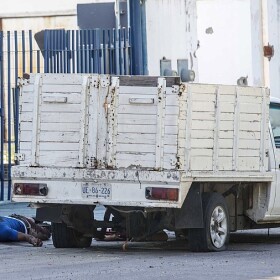Two deadly shootouts between Mexican law enforcement and cartels last week underscore how the country’s drug war continues to rage on, driving more Mexican migrants to seek asylum in the United States.
Last Monday, 13 police officers were killed in an ambush in the Mexican state of Michoacán when they were attempting to serve a single warrant. On Thursday, the city of Culiacán in the cartel stronghold of Sinaloa became a war zone. A military operation to arrest a son of imprisoned cartel leader El Chapo was met with armed cartel members who shut the city down and took soldiers hostage.
But these extraordinary incidents aren't really typical of recent drug violence in Mexico, said University of San Diego professor Ev Meade.
Instead, violence has been focused on members of civil society, like politicians and activists. Meade has studied peacebuilding efforts in Mexico amidst the drug war.
“It’s not that there’s more violence either, because the actual quantities of violence ebbs and flows,” Meade told KPBS. “It’s that ordinary civilians, and particularly people who are doing any kind of civic activity that seeks to reinforce the rule of law. They’ve become targets in a way that they hadn’t been 10 years ago.”
RELATED: University Of San Diego: Mexico’s Violence Isn’t Just About Drugs
As the violence has become more distributed throughout society in Mexico, the number of Mexicans arrested at the U.S. southern border has steadily risen, bucking a yearslong decline.
Mexicans arrested by U.S. Border Patrol at the southern border rose by 25% from the end of July to the end of September, according to statistics compiled by the Washington Post.
In immigration court in San Diego, many Mexican asylum-seekers hail from the rural state of Michoacán.
“Especially in these rural communities, I think people just feel incredibly vulnerable,” Meade said. “I mean, if you look at the last election cycle and the level of political violence, it’s incredible. There were almost 500 incidents of violence against politicians and poll workers, just leading up to the 2018 election. We’ve had more than 80 mayors killed in Mexico since the drug war intensified.”
With Mexican President Andrés Manuel López Obrador facing calls to intensify his response to cartel violence, Mexico is once again at a crossroads for how to stop the killing. Both increased enforcement, or allowing the cartels to continue to target wide swaths of society, will probably lead to further bloodshed.









